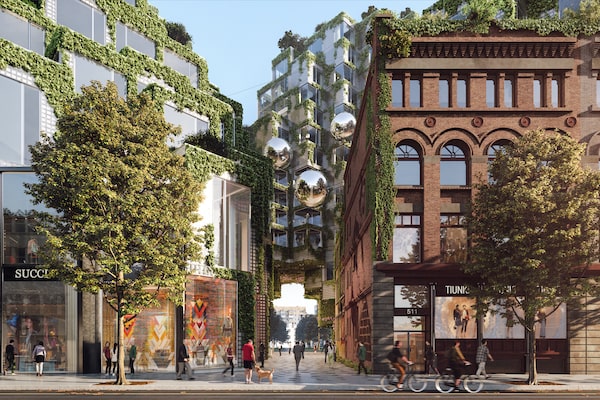
The best and most interesting Toronto developments, such as the Honest Ed’s, Galleria Mall and King Toronto projects, will succeed despite the rules.Supplied
Forty years ago, Toronto city hall had an in-house group of troublemakers. The urban-design group, first led by Ken Greenberg, were architects and planners who coloured outside the lines: They talked with colleagues from different disciplines to make a better city. They transformed parking lots into Berczy Park and the Toronto Sculpture Garden.
Today’s Toronto is changing, but that freewheeling culture is gone. It’s time to bring it back. Toronto’s current director of urban design, the well-respected Lorna Day, is leaving her job, and the city is seeking a replacement.
The position is largely about setting policy and responding to private developments. It has no strong mandate for change. But a new director could – and should – shake things up.
How so? By thinking about the city’s challenges in terms of place and design, not rules and silos. This is hard. Planning has lots of paperwork. Public agencies often don’t confer.
Yet Toronto has a series of knotty problems that demand creative co-operation. The biggest: the state of the neighbourhoods. Toronto will likely add a million people in the next generation, but planning policy has locked down the residential districts that cover most of the city. This has to change – Ontario policy demands it – and planners are starting a project to “expand housing options in neighbourhoods.” Still; planning tends to be slow and reactive.

Artist's rendering of the Westbank King Street development in Toronto.HayesDavidson
A more entrepreneurial approach would help. “Urban design has a critical role to play through proactive problem solving,” Mr. Greenberg said recently. “At its best, it is entrepreneurial and opportunistic, using a design-based ‘way of thinking’ to see otherwise missed relationships.” The key is “to seize opportunities not just in narrow slices seen through disciplinary lenses,” he said, “but deal with the full reality of the urban situation and all the actors who are shaping the city.”
To take one example, the Toronto District School Board: It has hundreds of public sites that are underused, too often being closed and sold piecemeal. How can those places get new life? Who’s going to solve the complicated issues of heritage, architecture, landscape, real estate and planning? An urban design chief.
But even if the job doesn’t change in that way, Toronto planning needs a talented and creative designer at the top. In recent years, the city has created a phonebook’s worth of plans and guidelines. These reinforce the overall trends in Toronto planning: the economic segregation of the city and the hollowing out of neighbourhoods.
And in the details of landscape and architecture, the rules aren’t always helpful. The best and most interesting Toronto developments, such as the Honest Ed’s, Galleria Mall and King Toronto projects, will succeed despite them.
In this environment, it’s crucial to have someone who knows which battles to fight and which goals to pursue. Make great public buildings; bring really beautiful places to less privileged neighbourhoods. Leave the good developments alone, and micromanage the bad ones.
It should be an architect or landscape architect, and someone from outside city hall. Someone with a great eye for design and a commitment to social justice. And a willingness to make trouble.